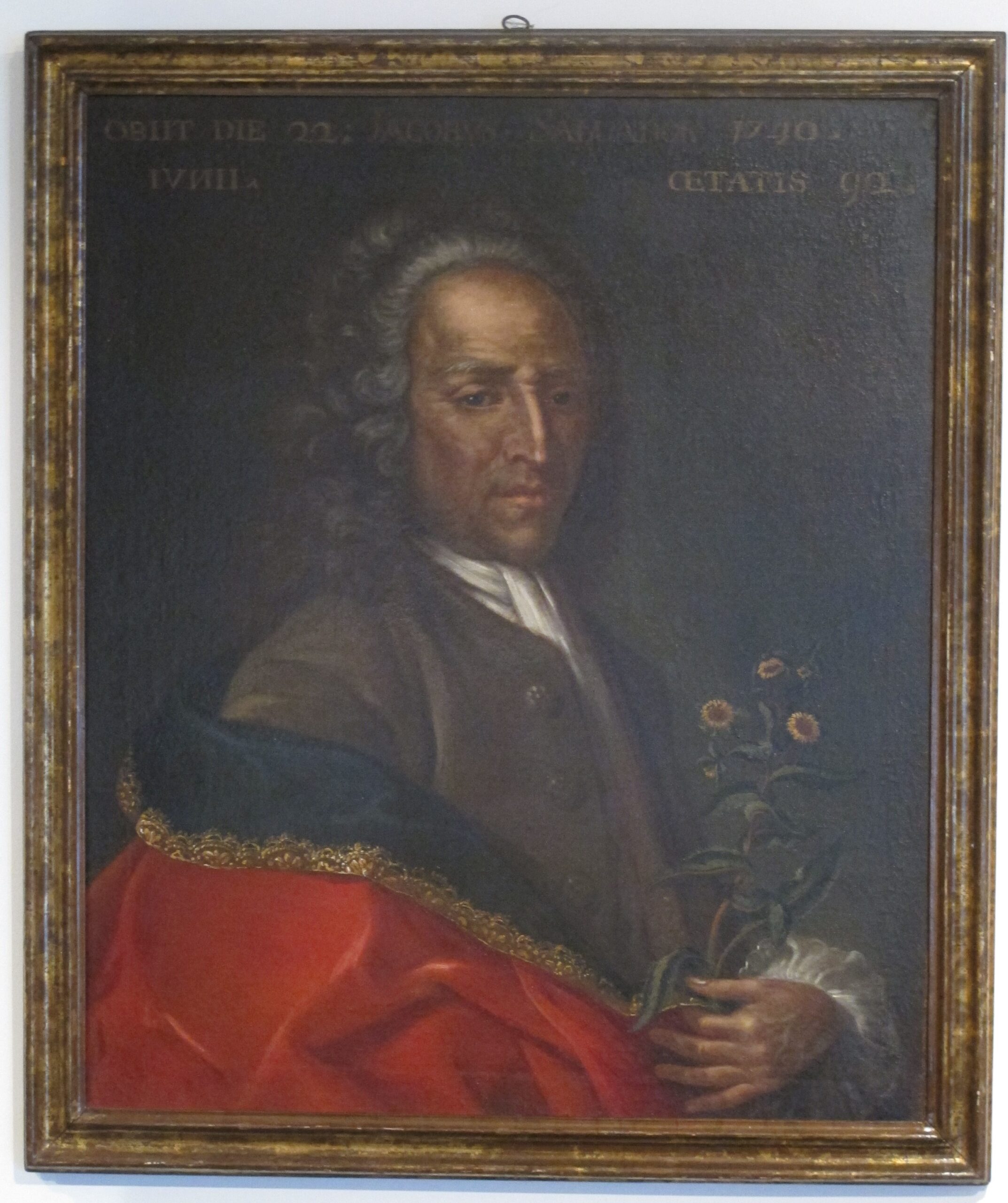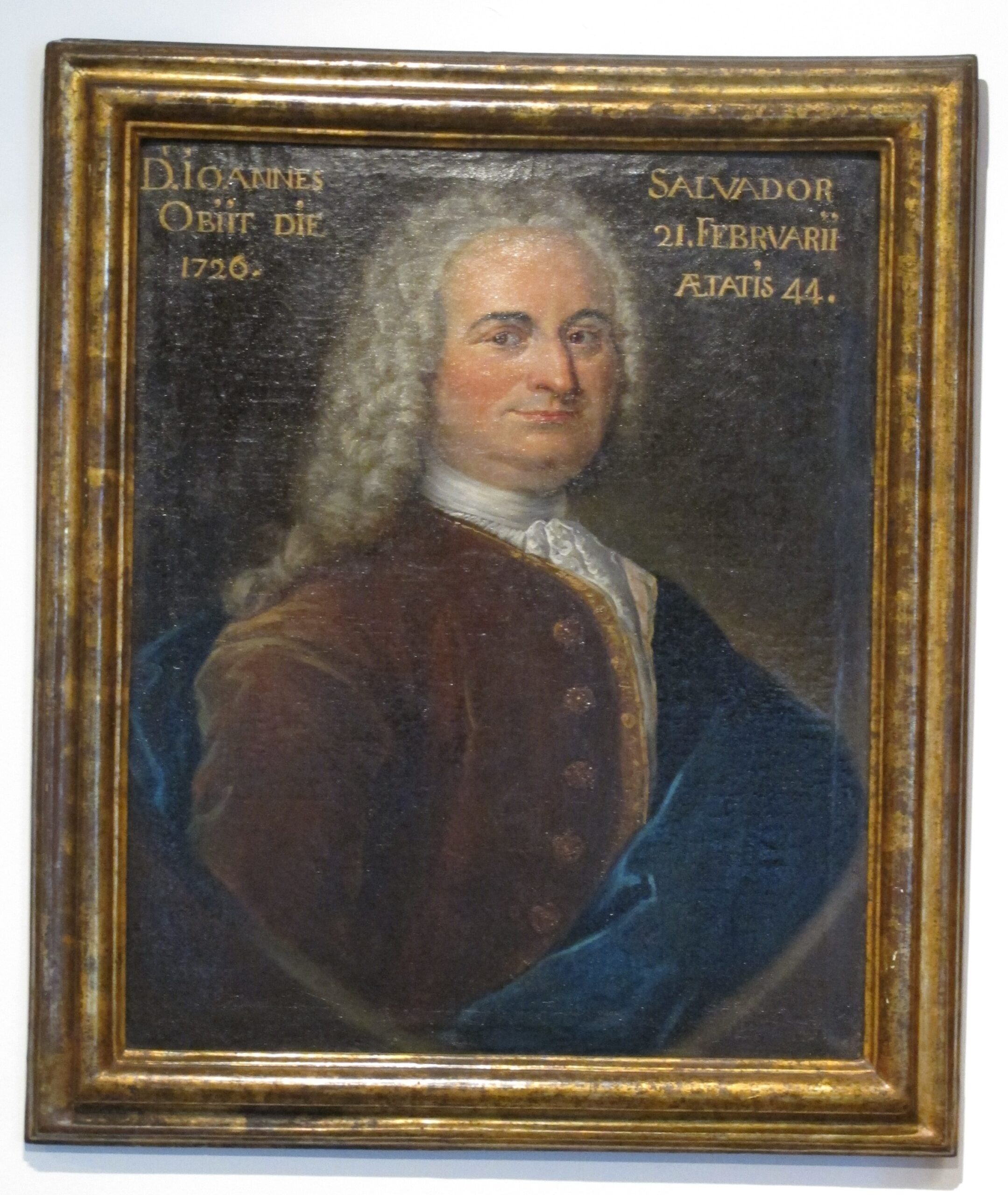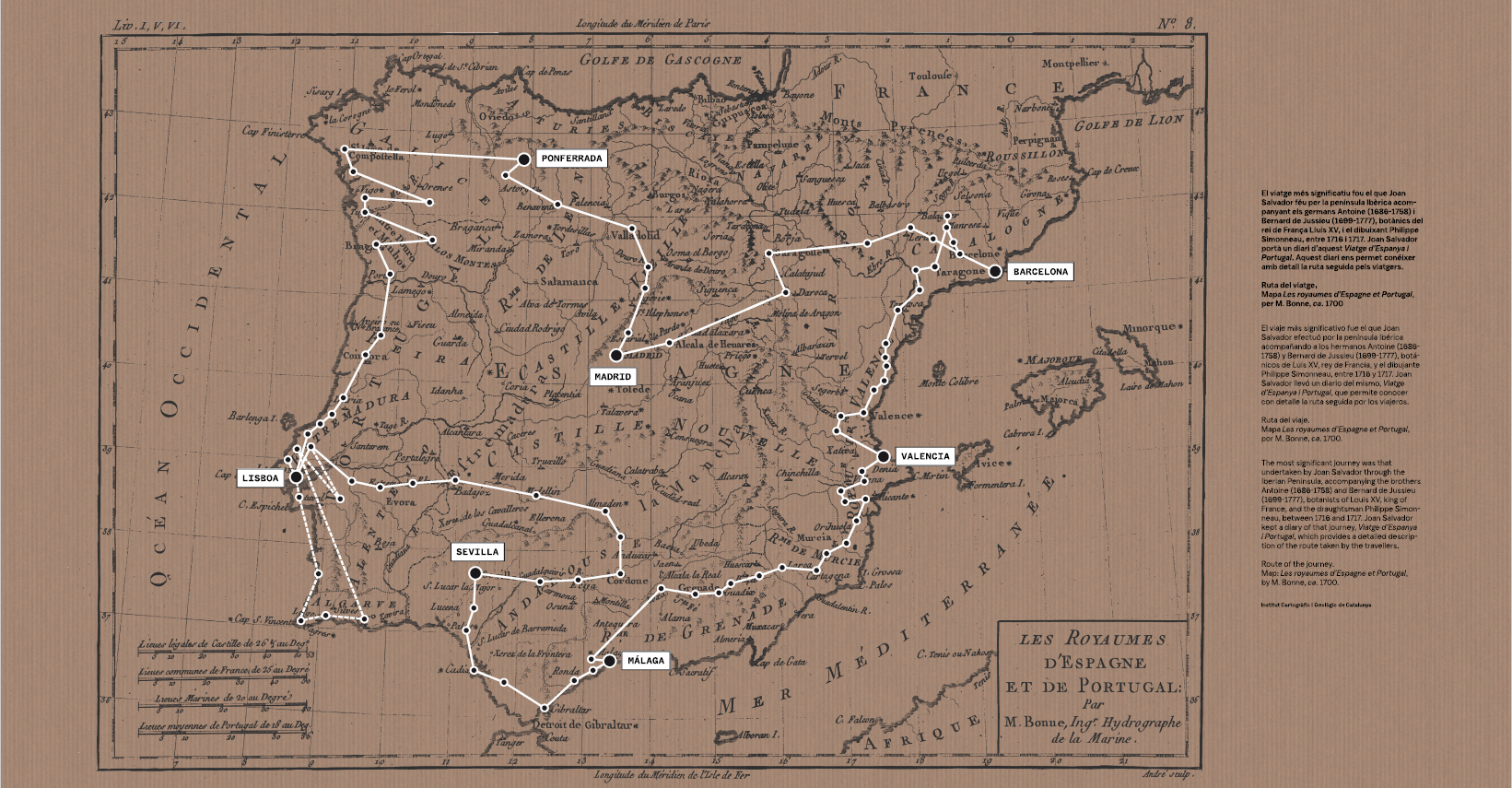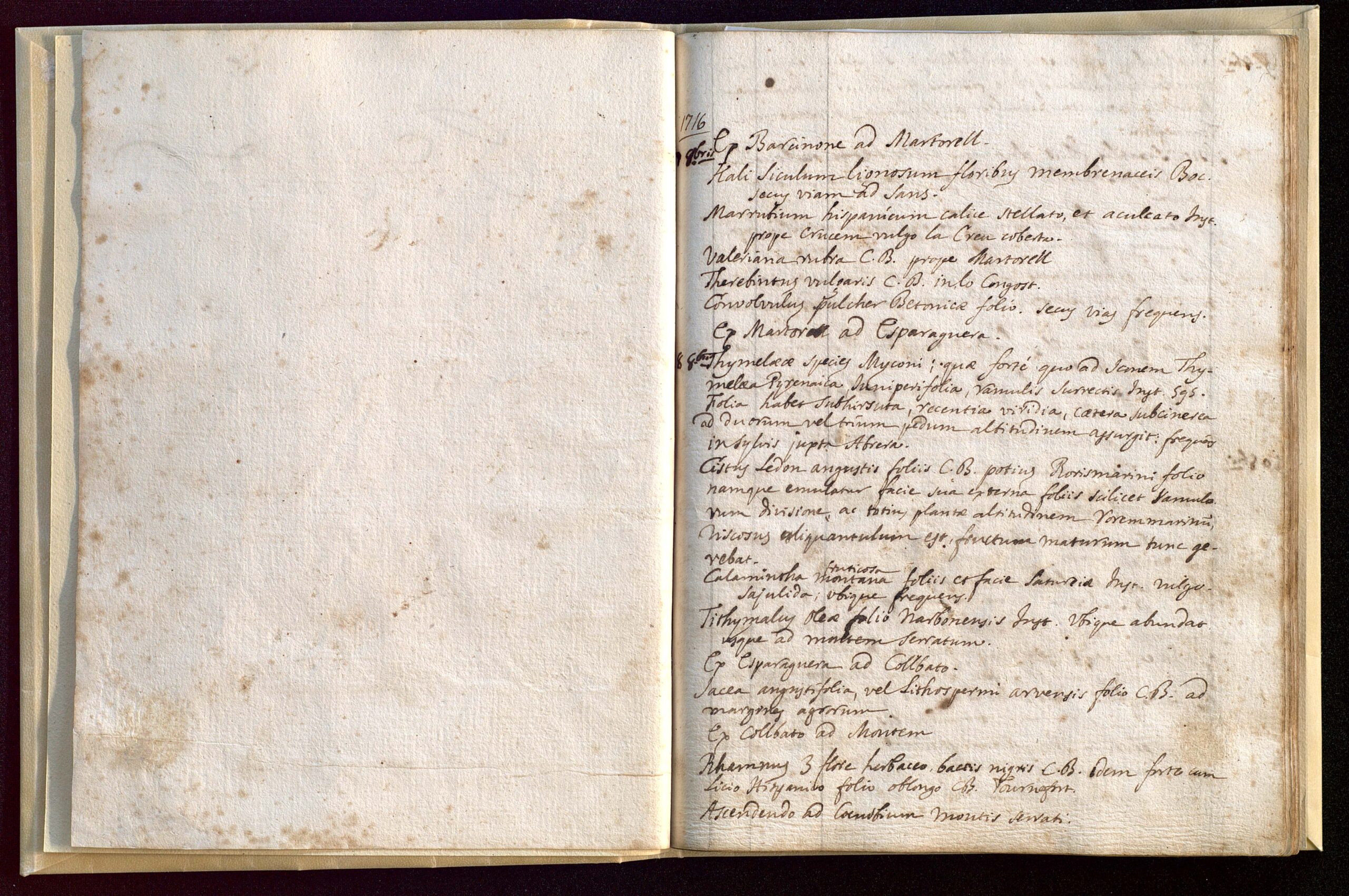
The Salvador family’s contribution to the botany in the Iberian Peninsula
The Salvador family was a well-known family of apothecaries from Barcelona, who developed their work around naturalism between the 17th and 19th centuries. They collected samples in the Iberian Peninsula and the Balearic Islands, creating one of the first scientific botanical gardens in Sant Joan Despí (Barcelona) while keeping correspondence and exchanges of books and objects with naturalists of great importance at that time such as Joseph Pitton de Tournefort, James Petiver, Herman Booerhave or the Jussieu brothers. As a result of the intense work of various generations, the Salvadors created a scientific cabinet, which was placed in the back room of their old pharmacy, in the centre of Barcelona. The cabinet was formed by a magnificent library, an herbarium (the oldest known in Spain), handwritten documents, collections of molluscs, fossils, drugs and several pieces of vegetables and stuffed animals.
Figure 1. Jaume Salvador
Source: Botanical Institute of Barcelona (IBB, CSIC-Barcelona City Council)
Jaume Salvador i Pedrol (1649-1740) (figure 1), apothecary, studied in Montpellier with Pèire Magnol (1638-1715), one of the most notable pre-Linnaean botanists, and was a friend and colleague of Joseph Pitton de Tournefort (1656-1708), also a disciple of Magnol and author of the more widespread classification method until the advent of the Linnaean system. In 1687, Jaume Salvador, in the company of Tournefort, made a botanical exploration trip along the coast of Catalonia and the Valencian Country as far as Dénia and Alicante, of which numerous testimonies are preserved in the herbarium; on the other hand, he significantly expanded the collections and the library acquired by his father.
Joan Salvador i Riera (1683-1725) (figure 2), son of Jaume, and probably the most relevant figure in the history of natural sciences in Spain at that time, came into contact with a wide variety of scientific environments. He also went to Montpellier, where he was a disciple of Magnol (1704-1705) and the Provencal Peire-Joseph Garidel (1659-1737). In Paris, he was a direct disciple of Tournefort (1705-1706), who hosted him in his house. He was also familiar with another botanist who was to stand out in the future and influence Catalan and world botany, Antoine de Jussieu (1686-1758), with whom he maintained a prolific correspondence. Unfortunately, during his stay in Paris, the War of Spanish Succession broke out, so he found himself in an enemy country and had to go to Italy.
Figure 2. Joan Salvador
Source: Botanical Institute of Barcelona (IBB, CSIC-Barcelona City Council)
When he returned to Barcelona in 1706, he found his father’s apothecary converted into an improvised academy where apothecaries, doctors and surgeons, both Catalan and from the allied armies of the king and archduke of Austria, met, in which he quickly integrated. From that moment his scientific prestige began to spread and he established fruitful correspondences with scientific personalities such as the British Hans Sloane (1660-1753, the future founder of the British Museum) or James Petiver (c. 1663-1718).
Joan Salvador, still in the middle of the War of Succession, in 1711, was the first to thoroughly explore Mallorca and Menorca from a botanical point of view, and he sent duplicates of his plant and seed collections to many of his correspondents. In 1716, Petiver published Petiveriana II, about plants from Montserrat mountain (Centre of Catalonia) sent by Joan Salvador. During this period Joan Salvador was working on a Botanomasticon catalonicum, now lost, which would probably have been the first flora of Catalonia. This work is known to have been seen by Peire Cusson in the library between 1726 and 1761 (specifically between 1740 and 1761, when the patriarch of the family, Jaume Salvador, had also died).
The correspondence with Petiver also allows us to date some trips in the Pyrenees. In a letter from Joan Salvador to James Petiver, dated Barcelona 2 August 1716, which can be found in the British Library, it is written: “J’arrive avant hier du Monts Pyrenées chargé de belles plantes, je vous en ferai part de toutes” (“I arrived before yesterday from the Pyrenean Mountains loaded with beautiful plants, I will let you know all of them “).
Figure 3. Trip around Spain and Portugal
Source: Botanical Institute of Barcelona (IBB, CSIC-Barcelona City Council)
The trip around the Iberian Peninsula
After the Pyrenean explorations, in October 1716, Joan Salvador repeated the adventure of the expedition through the Iberian Peninsula (figure 3) following Tournefort’s itineraries in the company of Antoine de Jussieu and Bernard, his brother (1699-1777), who at that time was 17 years old and years to come, would be also a remarkable botanist and active correspondent and supporter of Linné. In fact, the trip was wider than the Tournefort route and involved a journey of more than eight months through the entire peninsula, especially through Portugal. The purpose was to get to know the peninsular vegetation and collect the herbarium samples. Antoine de Jussieu had received this commission from the Académie Royale des Sciences de Paris: after the death of Tournefort (1708), he succeeded him in teaching botany at the Jardin du Roi, at that time the centre of European botany. The manuscript of the personal diary of this trip is still being studied by historians of science (figure 4).
Figure 4. Diary of the trip around Iberian Peninsula
Source: Botanical Institute of Barcelona (IBB, CSIC-Barcelona City Council)
This diary recounts the course of the journey made from October 1716 to May 1717 through the lands of Catalonia, the Valencian Country, Andalusia, Extremadura, Portugal, Galicia, León, Castile and Aragon. As pointed out above, the Salvador herbarium preserves a good number of specimens resulting from these expeditions. We also know of duplicates in the herbarium of Antoine de Jussieu and Bernard de Jussieu, which is currently part of the herbarium of Antoine Laurent de Jussieu (1748-1836) preserved in the Paris Museum; even some have notes by Joan and Jaume Salvador.
Joan Salvador also continued the correspondence and exchange of plants and seeds with the Dutchman Herman Boerhhave (1668-1738), initiated by his father in 1712. In his work Index alter Plantarum, appeared the first descriptions of ten plants from Spain, the Balearic Islands and Portugal sent and identified by Joan Salvador and cultivated in the Leiden Garden. Another botanist with whom Joan Salvador also corresponded was Laurent Garcin (1683-1752), who later dedicated the genus Salvadora to him.
Nowadays, this collection is currently exposed on the ground floor of the Botanical Institute of Barcelona (IBB), where the public can visit it. For security reasons and to ensure proper preservation, the entry into the cabinet is not allowed and the collection must be observed through the security glass protecting it. The visit is included within the entrance of the Botanical Garden of Barcelona (JBB). All the collection is digitalized and accessible through the platform Museu Obert.
Neus Ibáñez Cortina has a Ph.D. in Plant Biology from the University of Barcelona (2006). Her thesis focused on preserved historical herbaria at the Botanical Institute of Barcelona (IBB). From 2006 to 2008, she worked as a technician in the herbarium of the IBB. Since 2009, she is the curator of this herbarium and manages the specimens and historical herbariums, in addition to being the head of the department of collections and curator of the Cabinet of Curiosities of the Salvador family. Her main interests are to demonstrate changes in flora over time, extinctions, regressions or introduction of species through historical herbaria, and the search for type specimens and herbarium vouchers from taxonomic interest or nomenclature.





0 Comments